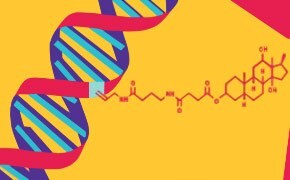Nucleic Acid Labeling & Detection

The range of labeling and detection methods for nucleic acids, PCR products, and oligonucleotides vary widely. The reagents and methods that are often used to label and detect nucleic acids are determined by several factors, including the type of molecule that will be labeled and the downstream application. Subsequently, both enzymatic and chemical methods are used to label nucleic acids and incorporate diverse molecules, such as fluorophores, enzymes, and radioactive elements.
Nucleic Acid Labeling and Probes
Nucleic acids can be labeled throughout the molecule or at the 5’ and 3’ ends. Nucleic acid probes are particularly useful for hybridization assays, such as the detection of RNA in northern blot or DNA in a Southern blot. Various labeling methods are used to distribute the label throughout the probe, including PCR with labeled deoxynucleotide (dNTPs) or nucleotide triphosphates (NTPs), random priming, and nick translation. End-labeling is particularly useful for assays investigating nucleic acid-protein interactions to avoid steric hindrance.
Nucleic Acid Labeling and Detection Assays
Depending on the labeling method, colorimetric detection is often used for enzyme-labeled probes, whereas autoradiographic detection is suitable for radioactive probes. Common probes include digoxigenin (DIG) and fluorescein-labeled probes and can be used in combination to facilitate multicolor probe detection when coupled to colorimetric reactions (e.g. alkaline phosphatase). Similarly, the incorporation of Biotin-16-dUTP using PCR is also possible with most DNA Polymerases as an additional labeling and detection method. Fluorescent in situ hybridization (FISH) uses fluorescent probes to detect DNA sequences and successful detection and downstream analysis is partially determined by the sensitivity and resolution of the fluorescent microscope available to the researcher.
Labelled DNA and RNA Applications
The transfer of macromolecules to solid-phase membranes is known as blotting. Due to the specificity of labeled probes, hybridization of the nucleic acid and the probe provides researchers with the ability to detect both DNA and RNA sequences in complex mixtures of nucleic acids. Furthermore, these methods allow for the gathering additional valuable information including analyzing gene expression, mRNA size, and copy number depending on the assay. In situ hybridization is also commonly used by researchers to detect one or more differently labeled probes (e.g. DIG and fluorescein-labeled probes).
Visit our document search for data sheets, certificates and technical documentation.
Related Articles
- Digoxigenin (DIG) labeling methods and kits for DNA and RNA DIG probes, random primed DNA labeling, nick translation labeling, 5’ and 3’ oligonucleotide end-labeling.
- Ethidium bromide is a well-known and widely used fluorescent dye in biotechnology research.
- Available Fluorescent in situ hybridization (FISH) procedures, reagents and equipment.
- Background and protocols describing the various methods used by molecular biologists to detect samples of protein or nucleic acids bound to membranes.
- Explore Locked Nucleic Acid and MGB. These oligo modifications offer stability and specificity in molecular analysis, making them ideal for research and diagnostic applications.
- See All (9)
Related Protocols
- There are several counterstains possible in combination with BM Purple (or NBT/BCIP in general), including FastGreen FCF and Nuclear Fast Red.
- FACS sorts cells based on light scattering and fluorescence for objective cell analysis.
- NBT/BCIP Stock Solution Protocol & Troubleshooting
- NBT/BCIP Ready-to-Use Tablets Protocol Troubleshooting
- NBT Protocol
- See All (12)
Find More Articles and Protocols
How Can We Help
In case of any questions, please submit a customer support request
or talk to our customer service team:
Email custserv@sial.com
or call +1 (800) 244-1173
Additional Support
- Chromatogram Search
Use the Chromatogram Search to identify unknown compounds in your sample.
- Calculators & Apps
Web Toolbox - science research tools and resources for analytical chemistry, life science, chemical synthesis and materials science.
- Customer Support Request
Customer support including help with orders, products, accounts, and website technical issues.
- FAQ
Explore our Frequently Asked Questions for answers to commonly asked questions about our products and services.
To continue reading please sign in or create an account.
Don't Have An Account?